
Home - Search - Browse - Alphabetic Index: 0- 1- 2- 3- 4- 5- 6- 7- 8- 9
A- B- C- D- E- F- G- H- I- J- K- L- M- N- O- P- Q- R- S- T- U- V- W- X- Y- Z
Soyuz T
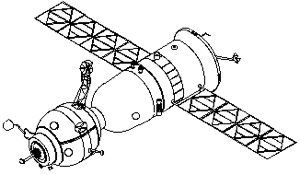 Soyuz T Credit: © Mark Wade |
AKA: 11F732;7K-ST. Status: Operational 1978. First Launch: 1978-04-04. Last Launch: 1986-03-13. Number: 18 . Thrust: 3.92 kN (881 lbf). Gross mass: 6,850 kg (15,100 lb). Unfuelled mass: 6,150 kg (13,550 lb). Specific impulse: 305 s. Height: 7.48 m (24.54 ft). Span: 10.60 m (34.70 ft).
It finally emerged as a complete redesign of the Soyuz in the late seventies. The Soyuz T introduced a revised Igla rendezvous system and a new service module with unitary translation / attitude control thrusters as part of a single bipropellant system with the main pump-fed engine. Solar panels were reintroduced; the fuel load was increased; and all new digital avionics were developed. Crew safety was improved with a new launch escape system and accommodation was provided for the first time for a three-man crew in spacesuits.
The USSR Defense Ministry issued a requirement for an "Orbital Research Station" (OIS) in March 1967 (reaffirmed in the decree of May 1968). This small station was to operate at an inclination of 51.6 degrees, an altitude of 250-270km, and have a flight duration of 30 days. Kozlov's Kuibyshev Branch of the former OKB-1 delivered a proposal for a Soyuz VI (7K-VI) complex in November 1967. (Not to be confused with the quite different Soyuz VI developed by Kozlov in the 1965-1967 period).
The new Soyuz was called by the OKB the 7K-S, and given the article number 11F732 by the military. The Soyuz-VI (abbreviation for military research) complex would consist of the OIS (with 700 to 1,000 kg of scientific equipment) and the Soyuz 7K-S. The Soyuz would have a crew if two, a probe-drogue docking system and an internal transfer tunnel.
The draft design for the OIS was released on 21 June 1968, followed by that for the 7K-S on 14 October 1968. Drawing release began in 1969. The OIS was cancelled in February 1970 after the start of the Salyut project. The Soyuz 7K-S, however continued in two parallel designs - the base variant, which was for special-purpose solo missions; and a space station transport variant 7K-ST. The revised designs for the 7K-S were completed on 11 August 1972.
The initial Soyuz 7K-S program was to consist of four unmanned, followed by two manned test flights, then two operational launches. Cosmonauts (among them Lyakhov and Voronov ) were assigned to the project in 1973. A State Commission was formed on 21 June 1974 to oversee the flight tests.
The draft design for 7K-ST space station transport version was completed in August 1974.
After the fourth N1 launch failure, a major reorganization of Soviet space enterprises was undertaken. Mishin was fired as head of the former OKB-1. After Kozlov turned down the job, Glushko was made head of a newly formed NPO Energia, combining OKB-1 and Glushko's Energomash engine production OKB. The 7K-S was cancelled; experiments planned for the 7K-S solo flights were transferred to the Salyut program.
Development of the launch escape system for 7K-S had run from 1968 to 1972. The new design was used for Soyuz Apollo-Soyuz Test Project version.
At the time the Soyuz 7K-S was cancelled, one of the uncrewed test vehicles was already at Tyuratam being prepared for launch. The first three were launched unmanned as technology tests - Cosmos 670 (7K-S No.1), Cosmos 772 (7K-S No.2), and Cosmos 869 (7K-S No.3).
The Soyuz 7K-ST transport project continued, except now being redesigned for a crew of three. The revised design for the new version was issued in 1975; and the first Soyuz T flew in 1978 as Cosmos 1001. The basic Soyuz T was adapted in the TM version for use with the Mir space station, and it would continue in use into the 21st Century as the Assured Crew Rescue Vehicle for the International Space Station.
Crew Size: 3. Orbital Storage: 180 days. Habitable Volume: 9.00 m3. Spacecraft delta v: 320 m/s (1,040 ft/sec). Electric System: 0.60 average kW.
More at: Soyuz T.
Family: Manned spacecraft, Space station orbit. Country: Russia. Engines: KDU-426. Spacecraft: Salyut 6, Soyuz T SA, Soyuz T BO, Soyuz T PAO, Salyut 7, Mir. Flights: Soyuz T-8, Soyuz T-10-1. Launch Vehicles: R-7, Soyuz-U, Soyuz-U2. Propellants: N2O4/UDMH. Launch Sites: Baikonur, Baikonur LC1, Baikonur LC31. Agency: Korolev bureau, MOM. Bibliography: 121, 2, 21, 32, 33, 382, 42, 51, 6, 89, 94, 6909, 13134.
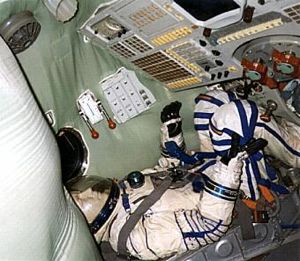 | Soyuz-T interior Credit: © Mark Wade |
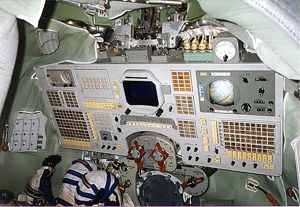 | Soyuz-T interior Credit: © Mark Wade |
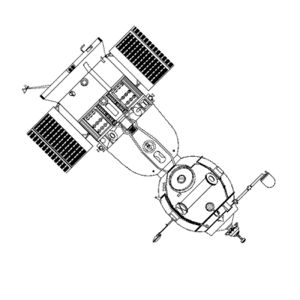 | Soyuz T Credit: © Mark Wade |
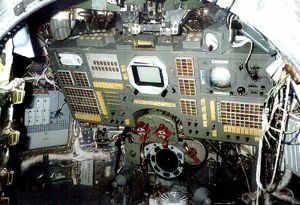 | Soyuz T panel Soyuz T control panel Credit: © Mark Wade |
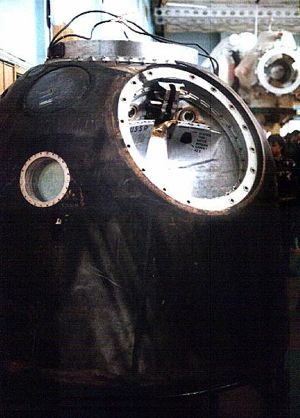 | Soyuz Descent Module Credit: © Mark Wade |
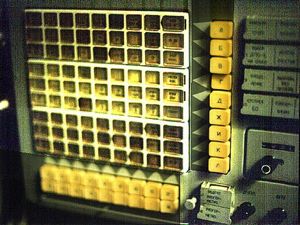 | Soyuz T panel Soyuz T control panel 1 Credit: © Mark Wade |
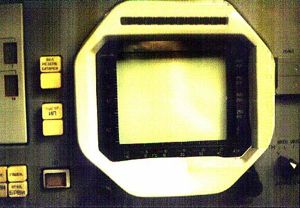 | Soyuz T panel Soyuz T control panel 2 Credit: © Mark Wade |
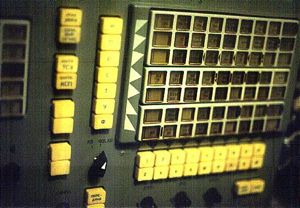 | Soyuz T panel Soyuz T control panel 3 Credit: © Mark Wade |
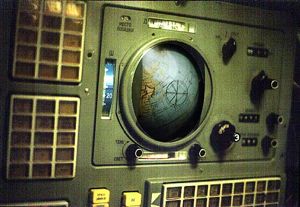 | Soyuz T panel Soyuz T control panel 4 Credit: © Mark Wade |
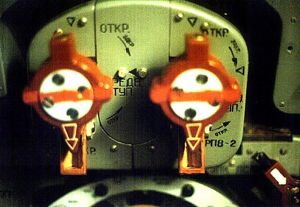 | Soyuz T panel Soyuz T control panel 5 Credit: © Mark Wade |
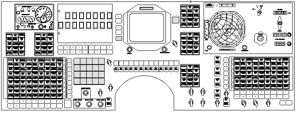 | Panel Soyuz TM Control panel of the Soyuz T/TM later version of the space station ferry vehicle.. Credit: © Mark Wade |
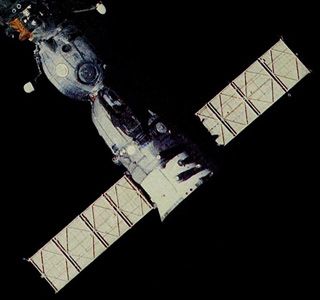 | Soyuz T-15 Credit: Manufacturer Image |
1974 July - .
- Soyuz 7K-S cancelled; Soyuz 7K-ST continued - .
Nation: Russia.
Spacecraft: Soyuz 7K-S,
Soyuz OB-VI,
Soyuz T.
The 7K-S was cancelled at the same time as the N1 and the reorganisation of the space industry. Experiments planned for the solo flights were transferred to the Salyut program. The first test vehicle was already at Baikonur being prepared for launch. It was decided to launch the first three unmanned as technology tests - Cosmos 670 (7K-S No.1), Cosmos 772 (7K-S No.2), and Cosmos 869 (7K-S No.3). The Soyuz 7K-ST transport project continued, except now being redesigned for a crew of three. The 7K-ST would eventually fly as the Soyuz T and Soyuz TM ferry to the Salyut 7 and Mir space stations.
1978 April 4 - . 15:00 GMT - . Launch Site: Baikonur. Launch Complex: Baikonur LC1. LV Family: R-7. Launch Vehicle: Soyuz-U.
- Cosmos 1001 - .
Payload: Soyuz T s/n 4L. Mass: 6,850 kg (15,100 lb). Nation: Russia.
Agency: MOM.
Program: Salyut 6.
Class: Manned.
Type: Manned spacecraft. Spacecraft Bus: Soyuz.
Spacecraft: Soyuz T.
Duration: 10.87 days. Decay Date: 1978-04-15 . USAF Sat Cat: 10783 . COSPAR: 1978-036A. Apogee: 228 km (141 mi). Perigee: 199 km (123 mi). Inclination: 51.60 deg. Period: 88.70 min.
Manned precursor. Recovered April 15, 1978 12:02 GMT. Unsuccessful mission. Soyuz T test -failure.
Maneuver Summary:
202 km X 231 km orbit to 195 km X 291 km orbit. Delta V: 19 m/s
195 km X 291 km orbit to 306 km X 322 km orbit. Delta V: 40 m/s
306 km X 322 km orbit to 308 km X 318 km orbit. Delta V: 1 m/s
Total Delta V: 60 m/s.
Officially: Investigation of the upper atmosphere and outer space.
1979 January 31 - . 09:00 GMT - . Launch Site: Baikonur. Launch Complex: Baikonur LC31. LV Family: R-7. Launch Vehicle: Soyuz-U.
- Cosmos 1074 - .
Payload: Soyuz T s/n 5L. Mass: 6,850 kg (15,100 lb). Nation: Russia.
Agency: MOM.
Program: Salyut 6.
Class: Manned.
Type: Manned spacecraft. Spacecraft Bus: Soyuz.
Spacecraft: Soyuz T.
Duration: 60.04 days. Decay Date: 1979-04-01 . USAF Sat Cat: 11259 . COSPAR: 1979-008A. Apogee: 238 km (147 mi). Perigee: 195 km (121 mi). Inclination: 51.60 deg. Period: 88.80 min.
Manned precursor. Recovered April 1, 1979 10:09 GMT. Soyuz T Test.
Maneuver Summary:
197 km X 240 km orbit to 255 km X 297 km orbit. Delta V: 33 m/s
255 km X 297 km orbit to 264 km X 306 km orbit. Delta V: 4 m/s
264 km X 306 km orbit to 309 km X 321 km orbit. Delta V: 17 m/s
309 km X 321 km orbit to 279 km X 357 km orbit. Delta V: 18 m/s
279 km X 357 km orbit to 352 km X 402 km orbit. Delta V: 32 m/s
352 km X 402 km orbit to 363 km X 384 km orbit. Delta V: 8 m/s
Total Delta V: 112 m/s
Officially: Investigation of the upper atmosphere and outer space.
1979 December 16 - . 12:29 GMT - . Launch Site: Baikonur. Launch Complex: Baikonur LC31. LV Family: R-7. Launch Vehicle: Soyuz-U.
- Soyuz T-1 - .
Payload: Soyuz T s/n 6L. Mass: 6,850 kg (15,100 lb). Nation: Russia.
Agency: MOM.
Program: Salyut 6.
Class: Manned.
Type: Manned spacecraft. Spacecraft Bus: Soyuz.
Spacecraft: Soyuz T.
Duration: 100.38 days. Decay Date: 1980-03-25 . USAF Sat Cat: 11640 . COSPAR: 1979-103A. Apogee: 252 km (156 mi). Perigee: 213 km (132 mi). Inclination: 51.60 deg. Period: 89.20 min.
New generation Soyuz capsule; unmanned flight to Salyut 6. Docked with Salyut 6. Recovered March 25, 1980 21:47 GMT. Unmanned test of Soyuz T design.
Officially: Complex experimental testing of new on-board systems and assemblies under various flight conditions and operation in conjunction with the Salyut-6 orbital station.
1980 June 5 - . 14:19 GMT - . Launch Site: Baikonur. Launch Complex: Baikonur LC1. LV Family: R-7. Launch Vehicle: Soyuz-U.
- Soyuz T-2 - . Call Sign: Yupiter (Jupiter ). Crew: Aksyonov, Malyshev. Backup Crew: Kizim, Makarov. Payload: Soyuz T s/n 7L. Mass: 6,850 kg (15,100 lb). Nation: Russia. Agency: MOM. Program: Salyut 6. Class: Manned. Type: Manned spacecraft. Flight: Soyuz 35, Soyuz T-2. Spacecraft Bus: Soyuz. Spacecraft: Soyuz T. Duration: 3.93 days. Decay Date: 1980-06-09 . USAF Sat Cat: 11825 . COSPAR: 1980-045A. Apogee: 232 km (144 mi). Perigee: 195 km (121 mi). Inclination: 51.60 deg. Period: 88.70 min. Test flight of new Soyuz T; docked with Salyut 6. Conducted testing and development of on-board systems in the improved Soyuz T series transport vehicle under piloted conditions..
1980 November - .
- Soyuz T-3A (cancelled) - . Crew: Lazarev, Polyakov, Strekalov. Backup Crew: Isaulov, Potapov, Rukavishnikov. Nation: Russia. Program: Salyut 6. Flight: Soyuz T-3A. Spacecraft Bus: Soyuz. Spacecraft: Soyuz T. Planned but cancelled manned flight. Crew dissolved when Lazarev failed physical in early 1981..
1980 November 27 - . 14:18 GMT - . Launch Site: Baikonur. Launch Complex: Baikonur LC1. LV Family: R-7. Launch Vehicle: Soyuz-U.
- Soyuz T-3 - .
Call Sign: Mayak (Beacon ). Crew: Kizim,
Makarov,
Strekalov.
Backup Crew: Kovalyonok,
Polyakov,
Savinykh.
Payload: Soyuz T s/n 8L. Mass: 6,850 kg (15,100 lb). Nation: Russia.
Agency: MOM.
Program: Salyut 6.
Class: Manned.
Type: Manned spacecraft. Flight: Soyuz T-3.
Spacecraft Bus: Soyuz.
Spacecraft: Soyuz T.
Duration: 12.80 days. Decay Date: 1980-12-10 . USAF Sat Cat: 12077 . COSPAR: 1980-094A. Apogee: 260 km (160 mi). Perigee: 256 km (159 mi). Inclination: 51.60 deg. Period: 89.70 min.
Manned three crew. Docked with Salyut 6. Tested the improved transport ship of the 'SOYUZ T' series; transported to the Salyut-6 orbital station a crew consisting of L D Kizim, O G Makarov and G M Strekalov to carry out repair and preventive work and scientific and technical investigation and experiments.
1981 March 12 - . 19:00 GMT - . Launch Site: Baikonur. Launch Complex: Baikonur LC1. LV Family: R-7. Launch Vehicle: Soyuz-U.
- Soyuz T-4 - . Call Sign: Foton (Photon ). Crew: Kovalyonok, Savinykh. Backup Crew: Andreyev, Zudov. Payload: Soyuz T s/n 10L. Mass: 6,850 kg (15,100 lb). Nation: Russia. Agency: MOM. Program: Salyut 6. Class: Manned. Type: Manned spacecraft. Flight: Soyuz T-4. Spacecraft Bus: Soyuz. Spacecraft: Soyuz T. Duration: 74.73 days. Decay Date: 1981-05-26 . USAF Sat Cat: 12334 . COSPAR: 1981-023A. Apogee: 237 km (147 mi). Perigee: 201 km (124 mi). Inclination: 51.60 deg. Period: 88.90 min. Manned two crew. Docked with Salyut 6. Transported to the Salyut-6 orbital station cosmonauts V V Kovalenok and V P Savinykh to carry out repairs and preventive maintenance and scientific and technical investigations and experiments..
1982 May 13 - . 09:58 GMT - . Launch Site: Baikonur. Launch Complex: Baikonur LC1. LV Family: R-7. Launch Vehicle: Soyuz-U.
- Soyuz T-5 - . Call Sign: Elbrus (Elbrus - tallest mountain in Europe). Crew: Berezovoi, Lebedev. Backup Crew: Strekalov, Titov, Vladimir. Payload: Soyuz T s/n 11L. Mass: 6,850 kg (15,100 lb). Nation: Russia. Agency: MOM. Program: Salyut 7. Class: Manned. Type: Manned spacecraft. Flight: Soyuz T-5. Spacecraft Bus: Soyuz. Spacecraft: Soyuz T. Duration: 106.21 days. Decay Date: 1982-08-27 . USAF Sat Cat: 13173 . COSPAR: 1982-042A. Apogee: 231 km (143 mi). Perigee: 190 km (110 mi). Inclination: 51.60 deg. Period: 88.70 min. Carried Anatoli Berezovoi, Valentin Lebedev to Salyut 7 to conduct scientific research and experiments; returned crew of Soyuz T-7 to Earth..
1982 June 24 - . 16:29 GMT - . Launch Site: Baikonur. Launch Complex: Baikonur LC1. LV Family: R-7. Launch Vehicle: Soyuz-U.
- Soyuz T-6 - .
Call Sign: Pamir (Pamirs ). Crew: Chretien,
Dzhanibekov,
Ivanchenkov.
Backup Crew: Baudry,
Kizim,
Solovyov, Vladimir.
Payload: Soyuz T s/n 9L. Mass: 6,850 kg (15,100 lb). Nation: Russia.
Agency: MOM.
Program: Salyut 7.
Class: Manned.
Type: Manned spacecraft. Flight: Soyuz T-5,
Soyuz T-6.
Spacecraft Bus: Soyuz.
Spacecraft: Soyuz T.
Duration: 7.91 days. Decay Date: 1982-07-02 . USAF Sat Cat: 13292 . COSPAR: 1982-063A. Apogee: 233 km (144 mi). Perigee: 189 km (117 mi). Inclination: 51.70 deg. Period: 88.70 min.
Manned three crew. Docked with Salyut 7. Transported to the Salyut-7 orbital station the Soviet-French international crew, comprising V A Dzhanibekov (USSR), A S Ivanchenkov (USSR) and Jean-Loup Chretien (France) to conduct scientific research and experiments.
1982 August 19 - . 17:11 GMT - . Launch Site: Baikonur. Launch Complex: Baikonur LC1. LV Family: R-7. Launch Vehicle: Soyuz-U.
- Soyuz T-7 - . Call Sign: Dnepr (Dnieper ). Crew: Popov, Savitskaya, Serebrov. Backup Crew: Pronina, Romanenko, Savinykh. Payload: Soyuz T s/n 12L. Mass: 6,850 kg (15,100 lb). Nation: Russia. Agency: MOM. Program: Salyut 7. Class: Manned. Type: Manned spacecraft. Flight: Soyuz T-5, Soyuz T-7. Spacecraft Bus: Soyuz. Spacecraft: Soyuz T. Duration: 113.08 days. Decay Date: 1982-12-10 . USAF Sat Cat: 13425 . COSPAR: 1982-080A. Apogee: 299 km (185 mi). Perigee: 289 km (179 mi). Inclination: 51.60 deg. Period: 90.30 min. Docked with Salyut 7. Carried Svetlana Savitskaya, Leonid Popov, Alexander Serebrov to Salyut 7 to conduct scientific and technical research and experiments..
1983 April 20 - . 13:10 GMT - . Launch Site: Baikonur. Launch Complex: Baikonur LC1. LV Family: R-7. Launch Vehicle: Soyuz-U.
- Soyuz T-8 - . Call Sign: Okean (Ocean ). Crew: Serebrov, Strekalov, Titov, Vladimir. Backup Crew: Aleksandrov, Lyakhov, Savinykh. Payload: Soyuz T s/n 13L. Mass: 6,850 kg (15,100 lb). Nation: Russia. Agency: MOM. Program: Salyut 7. Class: Manned. Type: Manned spacecraft. Flight: Soyuz T-8. Spacecraft Bus: Soyuz. Spacecraft: Soyuz T. Duration: 2.01 days. Decay Date: 1983-04-22 . USAF Sat Cat: 14014 . COSPAR: 1983-035A. Apogee: 213 km (132 mi). Perigee: 196 km (121 mi). Inclination: 51.60 deg. Period: 88.60 min. Manned three crew. Unsuccessful mission. Failed to rendezvous with Salyut 7. Recovered April 22, 1983 13:29 GMT. Landed 113 km SE Arkalyk..
1983 June 27 - . 09:12 GMT - . Launch Site: Baikonur. Launch Complex: Baikonur LC1. LV Family: R-7. Launch Vehicle: Soyuz-U.
- Soyuz T-9 - . Call Sign: Proton (Proton ). Crew: Aleksandrov, Lyakhov. Backup Crew: Strekalov, Titov, Vladimir. Payload: Soyuz T s/n 14L. Mass: 6,850 kg (15,100 lb). Nation: Russia. Agency: MOM. Program: Salyut 7. Class: Manned. Type: Manned spacecraft. Flight: Soyuz T-9. Spacecraft Bus: Soyuz. Spacecraft: Soyuz T. Duration: 149.45 days. Decay Date: 1983-11-23 . USAF Sat Cat: 14152 . COSPAR: 1983-062A. Apogee: 228 km (141 mi). Perigee: 197 km (122 mi). Inclination: 51.60 deg. Period: 88.80 min. Manned two crew. Docked with Salyut 7. Transported to the Salyut-7 orbital station a crew consisting of V A Lyakhov, commander of the spacecraft, and A P Aleksandrov, flight engineer, to conduct scientific and technical research and experiments..
1983 September 26 - . 19:37 GMT - . Launch Site: Baikonur. Launch Complex: Baikonur LC1. LV Family: R-7. Launch Vehicle: Soyuz-U. FAILURE: Launch vehicle blew up on pad.. Failed Stage: 0.
- Soyuz T-10-1 - . Call Sign: Okean (Ocean). Crew: Strekalov, Titov, Vladimir. Backup Crew: Kizim, Solovyov, Vladimir. Payload: Soyuz 7K-ST s/n 16L. Mass: 6,850 kg (15,100 lb). Nation: Russia. Agency: UNKS. Program: Salyut 7. Class: Manned. Type: Manned spacecraft. Flight: Soyuz T-10-1, Soyuz T-9. Spacecraft Bus: Soyuz. Spacecraft: Soyuz T. Duration: 0.0001 days. Decay Date: 1983-09-27 . Apogee: 2.00 km (1.20 mi). Aborted September 27, 1983 19:38 GMT. Unsuccessful mission. Launch vehicle blew up on pad at Tyuratam; crew saved by abort system..
1984 February 8 - . 12:07 GMT - . Launch Site: Baikonur. Launch Complex: Baikonur LC31. LV Family: R-7. Launch Vehicle: Soyuz-U.
- Soyuz T-10 - .
Call Sign: Mayak (Beacon ). Crew: Atkov,
Kizim,
Solovyov, Vladimir.
Backup Crew: Polyakov,
Savinykh,
Vasyutin.
Payload: Soyuz 7K-ST s/n 15L. Mass: 6,850 kg (15,100 lb). Nation: Russia.
Agency: MOM.
Program: Salyut 7.
Class: Manned.
Type: Manned spacecraft. Flight: Soyuz T-10.
Spacecraft Bus: Soyuz.
Spacecraft: Soyuz T.
Duration: 62.95 days. Decay Date: 1984-04-11 . USAF Sat Cat: 14701 . COSPAR: 1984-014A. Apogee: 219 km (136 mi). Perigee: 199 km (123 mi). Inclination: 51.60 deg. Period: 88.70 min.
Manned three crew. Docked with Salyut 7. Transported a crew consisting of ship's commander L D Kizim, flight engineer V A Solovyov and cosmonaut-research O Y Atkov to the SALYUT-7 orbital station to conduct scientific and technical studies and experiments.
1984 April 3 - . 13:08 GMT - . Launch Site: Baikonur. Launch Complex: Baikonur LC31. LV Family: R-7. Launch Vehicle: Soyuz-U.
- Soyuz T-11 - .
Call Sign: Yupiter (Jupiter ). Crew: Malyshev,
Sharma,
Strekalov.
Backup Crew: Berezovoi,
Grechko,
Malhotra.
Payload: Soyuz T s/n 17L. Mass: 6,850 kg (15,100 lb). Nation: Russia.
Agency: MOM.
Program: Salyut 7.
Class: Manned.
Type: Manned spacecraft. Flight: Soyuz T-10,
Soyuz T-11.
Spacecraft Bus: Soyuz.
Spacecraft: Soyuz T.
Duration: 181.91 days. Decay Date: 1984-10-02 . USAF Sat Cat: 14872 . COSPAR: 1984-032A. Apogee: 224 km (139 mi). Perigee: 195 km (121 mi). Inclination: 51.60 deg. Period: 88.70 min.
Manned three crew. Docked with Salyut 7.Transported a Soviet-Indian international crew comprising ship's commander Y V Malyshev, flight engineer G M Strekalov (USSR) and cosmonaut-researcher R Sharma (India) to the SALYUT-7 orbital station to conduct scientific and technical studies and experiments.
1984 July 17 - . 17:40 GMT - . Launch Site: Baikonur. Launch Complex: Baikonur LC31. LV Family: R-7. Launch Vehicle: Soyuz-U2.
- Soyuz T-12 - . Call Sign: Pamir (Pamir mountains). Crew: Dzhanibekov, Savitskaya, Volk. Backup Crew: Ivanova, Savinykh, Vasyutin. Payload: Soyuz T s/n 18L. Mass: 7,020 kg (15,470 lb). Nation: Russia. Agency: MOM. Program: Salyut 7. Class: Manned. Type: Manned spacecraft. Flight: Soyuz T-10, Soyuz T-12. Spacecraft Bus: Soyuz. Spacecraft: Soyuz T. Duration: 11.80 days. Decay Date: 1984-07-29 . USAF Sat Cat: 15119 . COSPAR: 1984-073A. Apogee: 218 km (135 mi). Perigee: 192 km (119 mi). Inclination: 51.60 deg. Period: 88.60 min. Docked with Salyut 7. Transported a crew comprising ship's commander V A Dzhanibekov, flight engineer S E Savitskaya and cosmonaut-research I P Volk to the Salyut-7 orbital station to conduct scientific and technical studies and experiments..
1985 March - .
- Soyuz T-13A (cancelled) - . Crew: Savinykh, Vasyutin, Volkov, Aleksandr. Backup Crew: Aleksandrov, Saley, Viktorenko. Nation: Russia. Program: Salyut 7. Flight: Soyuz T-13A. Spacecraft Bus: Soyuz. Spacecraft: Soyuz T. A mission was planned from 1982 to operate the military experiments aboard TKS-3 after it had docked with Salyut 7. Salyut 7 problems resulted in a complete breakdown of the TKS-3 plans and the crew was split-up and launched on two seperate flights..
1985 June 6 - . 06:39 GMT - . Launch Site: Baikonur. Launch Complex: Baikonur LC1. LV Family: R-7. Launch Vehicle: Soyuz-U2.
- Soyuz T-13 - .
Call Sign: Pamir (Pamir mountains). Crew: Dzhanibekov,
Savinykh.
Backup Crew: Aleksandrov,
Popov.
Payload: Soyuz T s/n 19L. Mass: 6,850 kg (15,100 lb). Nation: Russia.
Agency: MOM.
Program: Salyut 7.
Class: Manned.
Type: Manned spacecraft. Flight: Soyuz T-13 EO-4-a,
Soyuz T-13 EO-4-b.
Spacecraft Bus: Soyuz.
Spacecraft: Soyuz T.
Duration: 112.13 days. Decay Date: 1985-09-26 . USAF Sat Cat: 15804 . COSPAR: 1985-043A. Apogee: 222 km (137 mi). Perigee: 198 km (123 mi). Inclination: 51.60 deg. Period: 88.70 min.
Docked with Salyut 7. Delivered to the Salyut-7 orbital station a crew consisting of flight commander V A Dzhanibekov and flight engineer V P Savinykh to carry out emergency repairs to inert Salyut 7 station and to conduct scientific and technical research and experiments.
1985 September 17 - . 12:38 GMT - . Launch Site: Baikonur. Launch Complex: Baikonur LC1. LV Family: R-7. Launch Vehicle: Soyuz-U2.
- Soyuz T-14 - .
Call Sign: Cheget (Tcheget - mountain in the Caucasus). Crew: Grechko,
Vasyutin,
Volkov, Aleksandr.
Backup Crew: Saley,
Strekalov,
Viktorenko.
Payload: Soyuz T s/n 20L. Mass: 6,850 kg (15,100 lb). Nation: Russia.
Agency: MOM.
Program: Salyut 7.
Class: Manned.
Type: Manned spacecraft. Flight: Soyuz T-13 EO-4-a,
Soyuz T-13 EO-4-b,
Soyuz T-14 EO-4-c,
Soyuz T-14 Salyut 7 EP-5.
Spacecraft Bus: Soyuz.
Spacecraft: Soyuz T.
Duration: 64.91 days. Decay Date: 1985-11-21 . USAF Sat Cat: 16051 . COSPAR: 1985-081A. Apogee: 223 km (138 mi). Perigee: 196 km (121 mi). Inclination: 51.60 deg. Period: 88.70 min.
Docked with Salyut 7. Transported a crew comprising ship's commander V V Vasyutin, flight engineer G M Grechko and cosmonaut-researcher A A Volkov to the Salyut-7 orbital station to conduct scientific and technical studies and experiments. Grechko returned in Soyuz T-13 on 25 September 1985 - emergency return.
1986 Early - .
- Soyuz T-15A (cancelled) - . Crew: Levchenko, Manarov, Volynov. Backup Crew: Berezovoi, Shchukin, Solovyov. Nation: Russia. Program: Salyut 7. Flight: Soyuz T-15A. Spacecraft Bus: Soyuz. Spacecraft: Soyuz T. Final expedition to Salyut 7 station was cancelled when control was lost..
1986 March 13 - . 12:33 GMT - . Launch Site: Baikonur. Launch Complex: Baikonur LC1. LV Family: R-7. Launch Vehicle: Soyuz-U2.
- Soyuz T-15 - .
Call Sign: Mayak (Beacon ). Crew: Kizim,
Solovyov, Vladimir.
Backup Crew: Aleksandrov,
Viktorenko.
Payload: Soyuz T 11F732 s/n 21L. Mass: 7,020 kg (15,470 lb). Nation: Russia.
Agency: MOM.
Program: Mir.
Class: Manned.
Type: Manned spacecraft. Flight: Soyuz T-15.
Spacecraft Bus: Soyuz.
Spacecraft: Soyuz T.
Duration: 125.00 days. Decay Date: 1986-07-16 . USAF Sat Cat: 16643 . COSPAR: 1986-022A. Apogee: 366 km (227 mi). Perigee: 331 km (205 mi). Inclination: 51.60 deg. Period: 91.50 min.
Mir Main Expedition EO-01. Epic repair mission. The crew, consisting of ship's commander L D Kizim and flight engineer V A Solovyov first docked with the Mir orbital station to conduct scientific and technical studies and experiments. Mir then maneuvered 17 April to match Salyut 7's orbit at 4000 km separation, then again on 4 May to catch up. After six weeks aboard Mir, Soyuz T-15 undocked on 5 May, then rendezvoused and manually docked with the inoperative Salyut 7 station. This was the only flight in history by a single spacecraft between two space stations. The Salyut-7 station was found to be ice bound and without electrical power. The crew repaired the station, regaining power, heat, and environmental control. The also removed experimental results left behind by last crew. Soyuz T-15 undocked Salyut 7 on 25 June, and redocked with Mir on 26 June, delivering 400 kg of scientific material from Salyut 7, including a multichannel spectrometer. Following further work aboard Mir, the crew landed on July 16, 1986 at 12:34 GMT. No crew ever revisited Salyut 7; it made an uncontrolled reentry over Argentina.
1986 June - .
- Soyuz T-15B (cancelled) - . Crew: Aleksandrov, Saley, Viktorenko. Backup Crew: Moskalenko, Serebrov, Solovyov. Nation: Russia. Program: Salyut 7. Flight: Soyuz T-15B. Spacecraft Bus: Soyuz. Spacecraft: Soyuz T. Planned second crew to opeate TKS-3 military experiments aboard Salyut 7 before control of the station was lost. Salyut 7 and Cosmos 1686 burned up in the atmosphere together in a fiery show over Argentina on February 7, 1991..
1986 September - .
- Soyuz T-15C (cancelled) - .
Crew: Dobrokvashina,
Ivanova,
Savitskaya.
Backup Crew: Aleksandrov,
Solovyov,
Viktorenko.
Mass: 7,150 kg (15,760 lb). Nation: Russia.
Program: Salyut 7.
Flight: Soyuz T-15C.
Spacecraft Bus: Soyuz.
Spacecraft: Soyuz T.
Cancelled all-female flight to be launched on International Woman's Day, to have docked with Mir or Salyut 7. Breakdown of Salyut 7, exhaustion of stock of Soyuz T spacecraft, and official resistance led to cancellation of the mission. Officially cancelled due to birth of Savitskaya's baby. No female cosmonauts would be in training again until a decade later.
Back to top of page
Home - Search - Browse - Alphabetic Index: 0- 1- 2- 3- 4- 5- 6- 7- 8- 9
A- B- C- D- E- F- G- H- I- J- K- L- M- N- O- P- Q- R- S- T- U- V- W- X- Y- Z
© 1997-2019 Mark Wade - Contact
© / Conditions for Use